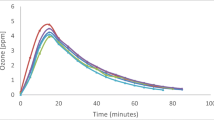Abstract
Ozone was found to reduce the numbers of bacteria detectable by plate counts and the numbers of presumptiveLegionella pneumophila (DFA-reactive cells), including those that were INT positive, in test cooling towers. The numbers of DFA-reactiveL. pneumophila eventually reached those of the makeup water (Troy, NY, city water). Microbial slime on the interior tower surfaces andPseudomonas populations in the tower waters were also reduced. Water chemistry parameters measured showed no tendency toward a condition that would cause accelerated deterioration of tower material.
Similar content being viewed by others
Literature Cited
American Public Health Association. 1980. Standard methods for the examination of water and wastewater, 15th edn. Washington, DC: American Public Health Association.
Broome, C. V., Goings, S. A. J., Thacher, S. B., Vogt, R. L., Braty, H. N., Fraser, D. W., The Field Investigating Team. 1979. The Vermont epidemic of Legionnaires' disease. Annual of Internal Medicine90:573–577.
Characklis, W. G. 1973. Attached microbial growths. II. Frictional resistance due to microbial slimes. Water Research7:1249–1258.
Cordes, L. G., Fraser, D. W. Skaliy, P., Perlino, C. A., Elsea, W. P., Mallison, G. F., Hayes, P. S. 1980. Legionnaires' disease outbreak at an Atlanta, Georgia, country club: evidence for spread from an evaporative condenser. American Journal of Epidemiology111:425–431.
Dondero, T. J., Rendtorff, R. C., Mallison, G. F., Weeks, R. M., Levy, J. S., Wong, E. W., Schaffner, W. 1980. An outbreak of Legionnaires' disease associated with a contaminated air-conditioning cooling tower. New England Journal of Medicine302:365–370.
Edelstein, P. H., Whittaker, R. E., Kreiling, R. L., Howell, C. L. 1982. Efficacy of ozone in eradication ofLegionella pneumophila from hospital plumbing fixtures. Applied and Environmental Microbiology44:1330–1334.
England, III., A. C., Fraser, D. W., Mallison, G. F., Mackel D. C., Skaliy, P., Gorman, G. W. 1982. Failure ofLegionella pneumophila sensitivities to predict culture results from disinfectant-treated air-conditioning cooling towers. Applied and Environmental Microbiology43:240–244.
Fliermans, C. B., Bettinger, G. E., Fynsk, A. S. 1982. Treatment of cooling systems containing high levels ofLegionella pneumophila. Water Research16:903–909.
Fliermans, C. B., Cherry, W. B., Orrison, L. H., Thacker, L. 1979. Isolation ofLegionella pneumophila from nonepidemic-related aquatic habitats. Applied and Environmental Microbology37:1239–1242.
Fliermans, C. B., Soracco, R. J., Pope, D. H. 1981. Measure ofLegionella pneumophila activity in situ. Current Microbiology6:89–94.
Garey, J. F. 1980. Selected alternatives to conventional chlorination: Final Report EA-1588 Research Project 1372. Palo Alto, CA: Electric Power Research Institute.
Glick, T. H., Gregg, M. B., Berman, B., Mallison, G., Rhodes, W. W., Kassanoff, I. 1978. Pontiac fever: an epidemic of unknown etiology in a health department. 1. Clinical and epidemiologic aspects. American Journal of Epidemiology107:149–160.
Grace, R. D., Dewar, N. E., Barnes, N. G., Hodges, G. R. 1981. Susceptibility ofLegionella pneumophila to three cooling tower microbicides. Applied and Environmental Microbiology41:233–236.
Hill, J., Kelleher, P. J., Kheiling, R. L., McBride, J. S. 1981. Ozone cooling water treatment in motels and large commercial complexes, pp. 43–54. In: Rice, R. G. (ed.), Ozone treatment of water for cooling applications Vienna, VA: International Ozone Association.
Humphrey, M. F. 1981. Cooling tower water conditioning study. Ozone: Science and Engineering2:109–119.
Merrill, D. T., Drago, J. A. 1978. Evaluation of ozone treatment in air-conditioning cooling towers. Research Project RP-1260-4. Walnut Creek, CA: Brown and Caldwell.
Nakayama, S., Tanaka, S., Tamauchi, S., Tabata, N. 1981. An antibiofouling ozone system for cooling water circuits. I. Application to fresh water circuits, pp. 159–167. In: Rice, R. G. (ed.), Ozone treatment of water for cooling applications. Vienna, VA. International Ozone Association.
Skaliy, P., Thompson, T. A., Gorman, G. W., Morris, G. K., McEachern, H. V., Mackel, D. C. 1980. Laboratory studies of disinfectants againstLegionella pneumophila. Applied Environmental Microbiology40:697–700.
Sugam, R., Singletary, J. H., Sandvik, W. A., Guerra 1981. Condenser biofouling control with ozone. Ozone: Science and Engineering3:95–107.
Tatnall, R. E. 1981. Fundamentals of bacteria induced corrosion. Materials Performance20(9):32–38.
Tyndall, R. 1982. Concentration, serotypic profiles, and infectivity of Legionnaire's disease bacteria populations in cooling towers. Journal of the Cooling Tower Institute3:25–33.
US Environmental Protection Agency. 1974. Steam electric power generating point source category effluent guidelines and standards 36. F. R. 36199.
Author information
Authors and Affiliations
Rights and permissions
About this article
Cite this article
Pope, D.H., Eichler, L.W., Coates, T.F. et al. The effect of ozone onLegionella pneumophila and other bacterial populations in cooling towers. Current Microbiology 10, 89–94 (1984). https://doi.org/10.1007/BF01575765
Issue Date:
DOI: https://doi.org/10.1007/BF01575765




